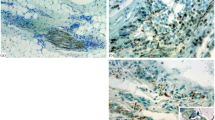Summary
The immunochemical localization of basic fibroblast growth factor was studied in ventricular ependyma of aged-matched normotensive and spontaneously hypertensive rats at different ages using a polyclonal antibody against bFGF. The basic fibroblast growth factor-like immunoreactivity was observed in brain ependyma of young and old normotensive rats. However, a progressive loss of immunoreactivity was observed with age in spontaneously hypertensive rats. These results show a new neuroendocrine anomaly to be added to the many others previously observed in the hypothalamo-neurohypophyseal system of this rat strain, when they develop hypertension as they get old.
Access this chapter
Tax calculation will be finalised at checkout
Purchases are for personal use only
Preview
Unable to display preview. Download preview PDF.
Similar content being viewed by others
References
A. Baird and P. Böhlen, Fibroblast growth factors, in “Peptide growth factors and their receptors”, M. B. Sporn and A. B. Roberts, eds, Springer, Berlin (1990).
F. Esch, A. Baird, N. Ling, N. Ueno, F, Hill, L. Denoroy, R. Klepper, D.Gospodarowicz, P. Bölen and R. Guillemin, Primary structure of bovine pituitary basic fibroblst growth factor (FGF) and comparison with the amino-terminal sequence of bovine brain acidic FGF, Proc. Natl. Acad. Sci. USA 82:6507 (1985).
G. Giménez-Gallego and P. Cuevas, Fibroblast growth factor, a protein with a broad spectrum of biological activities. Neurological Res. in press.
K. A. Thomas and G. Giménez-Gallego, Fibroblast growth factors: broad spectrum mitogens with potent angiogenic activity, Trends in Biol. Sci.11:1 (1986).
P. Cuevas, F. Carceller, S. Ortega, M. Zazo, I. Nieto and G. Giménez-Gallego,Hypotensive activity of fibroblast growth factor, Science 254:1208 (1991).
P. Cuevas, G. Giménez-Gallego, R. Martínez-Murillo and F. Carceller, Immunohisto-chemical localization of basic fibroblast growth factor in ependymal cells of the rat lateral and third ventricles, Acta Anatom. 141:307 (1991).
Y. Oomura K. Sasaki, K. Suzuki, T. Muto, A. Li, Z-I Ogita, K. Hanai, I. Tooyama, H.Kimura and N. Yanaihara, A new brain glucosensor and its physiological significance, Am. J. Clin. Nutr. 55:278S (1992).
R. Avidor, R. Eilam, R. Malach and I. Gozes, VIP-mRNA is increased in hypertensive rats, Brain Res. 503:304 (1989).
R. E. Lang, W. Rascher, T. Unger and D. Ganten, Reduced content of vasopresin in the brain of spontaneously hypertensive as compared to normotensive rats, Neurosci. Lett. 23:199(1981).
M. Morris and M Keller, A specific deficiency in para ventricular vasopressin and oxytocin in the spontaneous hypertensive rat, Brain Res. 249:173 (1982).
A. Nagaoka and W Lovenberg, Regional changes in the activities of aminergic biosynthetic enzymes in the brain of hypertensive rats, Eur. J. Pharmacol. 43:297 (1977).
M. Morris, J. A. Wren, D. K. Sundberg, Central neural peptides and catecholamines in spontaneous and DOCA/salt hypertension, Peptides 2:207 (1981).
D. O. Nelson and J. A. Boulant, Altered CNS neuroanatomical organization of spontaneous hypertensive rats, Brain Res. 226:119 (1981).
T. L. Krukoff and M. A. Weigel, Metabolic alteration in discrete regions of the rat brain during development of spontaneous hypertension, Brain Res. 499:1 (1989).
K. J. Anderson, D. Dam, S. Lee, C. W. Cotman, Basic fibroblast growth factor prevents death of lesioned cholinergic neurons in vivo, Nature 332:360 (1988).
P. Cuevas, F. Carceller, A. Esteban, A. Baird and R. Guillemin, Basic fibroblast growth factor (bFGF) enhances retinal ganglion cell survival and promotes growth of rat transected optic nerve, Acta Nerol. Scand. 79:263 (1988).
D. Otto, K. Unsicker and C. Grothe, Pharmacological effects of nerve growth factor and fibroblast growth factor applied to the transectioned sciatic nerve on neuron death in adult rat dorsal root ganglia, Neurosci. Lett. 83:156 (1987).
P. A. Walicke and A. Baird, Neurotrophic effects of basic and acidic fibroblast growth factors are not mediated through glial cells, Dev. Brain Res. 40:71 (1988).
D. Blottner, R. Westermann, C. Grothe, P. Böhlen and P. Unsicker, Basic fibroblast growth factor in the adrenal gland: Possible trophic role for preganglionic neurons in vivo, Eur. J. Neurosci. 1:471 (1989).
Jan Klein. “Immunology. The science of self-nonsense discrimination”. John Wliley & Sons. New York, 1982.
O. E. Millhouse, A Golgi study of third ventricle tanycites in the adult rodent brain, Z.Zellforsch. Mikrosk. Anat. 121:1 (1971).
R. Bleier, The relations of ependyma to neurons and capillaries in the hypothalamus.A Golgi-Cox-study. J. Comp. Neurol. 142:439 (1971).
D. E. Scott, G. Krobisch-Dudley, K. M. Knigge, The ventricular system in neuroendocrine mechanisms-II. In vivo monoamine transport by ependyma of the median eminence, Cell Tissue Res. 154:1 (1974).
P. M. Ma, Tanycytes in the sunfish brain: NADH-diaphorase histochemistry and regional distribution, J. Comp. Neurol. 336:77 (1993).
Author information
Authors and Affiliations
Editor information
Editors and Affiliations
Rights and permissions
Copyright information
© 1994 Springer Science+Business Media New York
About this chapter
Cite this chapter
Cuevas, P., Reimers, D., Carceller, F., Xiaobing, F., Giménez-Gallego, G. (1994). Loss of Basic Fibroblast Growth Factor of Brain Ependyma in Old Spontaneously Hypertensive Rats. In: Municio, A.M., Miras-Portugal, M.T. (eds) Cell Signal Transduction, Second Messengers, and Protein Phosphorylation in Health and Disease. Springer, Boston, MA. https://doi.org/10.1007/978-1-4615-1879-2_16
Download citation
DOI: https://doi.org/10.1007/978-1-4615-1879-2_16
Publisher Name: Springer, Boston, MA
Print ISBN: 978-1-4613-5765-0
Online ISBN: 978-1-4615-1879-2
eBook Packages: Springer Book Archive



